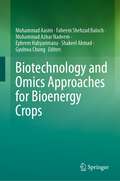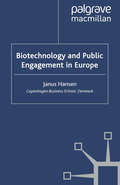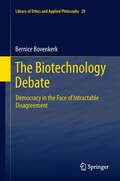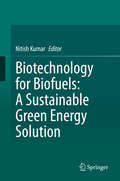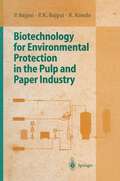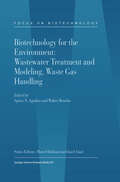- Table View
- List View
Biotechnology and Genetics in Fisheries and Aquaculture
by Andy Beaumont K. HoareThe recent development of molecular biology and genetic techniques, in particular those that are increasingly being used in practical situations in fish biology, fisheries and aquaculture, has led to a gap in the understanding by many of the science behind these techniques and their correct implementation for maximum results. The authors of this important book, Andy Beaumont and Kate Hoare, have written a text of great clarity, which carefully explains the science and application of molecular and genetic techniques to fisheries and aquaculture situations and what these new technologies have to offer. Contents include a full explanation of genetic variation and its measurement, genetic structure in natural populations, genetics and artificial selection in the hatchery, ploidy manipulation and the use of genetic engineering in aquaculture. Biotechnology and Genetics in Fisheries and Aquaculture is of great use to biological sciences students, particularly those studying marine, freshwater and aquatic biology, fish biology, fisheries, aquaculture, population biology and genetics. The book is also extremely useful as a reference to personnel such as fish farmers and fisheries scientists and all those working in fisheries and aquaculture management and research. Libraries in all universities and research establishments where biological sciences, fisheries and aquaculture are studied and taught should have copies of this book on their shelves.
Biotechnology And The New Agricultural Revolution
by Joseph J MolnarThe advent of new methods in shaping the performance characteristics of plants, animals, and microbes dramatically expands the possibilities for advances in agriculture -- a new "Green Revolution" in the offing. This book examines the impact of such developments on agricultural institutions, agribusiness, and farmers: What happens when a fundamenta
Biotechnology And The New Agricultural Revolution
by Joseph J MolnarThe advent of new methods in shaping the performance characteristics of plants, animals, and microbes dramatically expands the possibilities for advances in agriculture -- a new "Green Revolution" in the offing. This book examines the impact of such developments on agricultural institutions, agribusiness, and farmers: What happens when a fundamenta
Biotechnology and Omics Approaches for Bioenergy Crops
by Muhammad Aasim Faheem Shehzad Baloch Muhammad Azhar Nadeem Ephrem Habyarimana Shakeel Ahmad Gyuhwa ChungThis edited book summarizes the efforts made to develop sustainable bioenergy production through different generations. The topics included in the book cover information about different bioenergy crops, their classification and use as biofuel, agronomic practices to improve biomass yield, classic breeding techniques, genetic diversity, current status and future perspective of bioenergy crops in the omics era. It also discusses application of modern biotechnological and molecular biotechnological techniques for the improvement of bioenergy crops this having enhanced biomass and plant based products. The book explores growing biofuel crops and their impact on environment, bioethics and biosafety issues related to the modern approaches. Another important aspect is the incorporation of nanotechnology for bioenergy crops and biofuel production. All book chapters are contributed renowned researchers in their respective field. This is a unique book covering the bioeneragy crops in the modern omics era. The book is useful for the researchers and post-graduate students to guide them in the field of bioenergy crops.
Biotechnology and Polymers
by C. G. GebeleinThe term biotechnology has emerged on the contemporary scene fairly recently, but the basic concept of utilizing natural materials, either directly or in modified versions, dates back to antiquity. If we search the ancient literature, such as the Bible, we find hundreds of examples wherein people employed, or modified, natural materials for a variety of important uses. As far back as the days of Noah we find pitch, a natural material, being used as a caulk. Clothing was made from animal skins and the products of several plants. Today, we would consider these things as important biotechnological developments. Likewise, the human use of polymeric materials also has a long his tory. In fact, many of the original materials used by mankind were poly mers derived from nature, such as wood, flax, cotton, wool and animal skins, which were used for shelter and clothing. In recent years, however, the concept of biotechnology has taken on a new and renewed role in our society. This is due to a combination of factors, including an increased interest in environmental concerns and the desire to break free from the stranglehold that petrochemicals have placed on our society. If we can manufacture some of our polymers from renewable resources, then we can expect to prepare them for many more years into the future than we might if we could only depend on the petro chemical resources.
Biotechnology and Public Engagement in Europe
by J. HansenProviding a comparison the most important instances of public engagement with biotechnology in Europe in recent years, this book provides a theoretically reflected and empirically grounded study of the opportunities and obstacles for a thorough democratization of technological development through processes of public engagement.
Biotechnology and Sustainable Agriculture 2006 and Beyond: Proceedings of the 11th IAPTC&B Congress, August 13-18, 2006 Beijing, China
by Zhihong Xu Jiayang Li Yongbiao Xue Weicai YangThis timely work is a collection of papers presented at the XIth international congress of the International Association of Plant Tissue Culture & Biotechnology. It continues the tradition of the IAPTC&B in publishing the proceedings of its congresses. The work is an up-to-date report on the most significant advances in plant tissue culture and biotechnology as presented by leading international scientists. It will be crucial reading for agricultural scientists, among others.
Biotechnology Applied to Inflammatory Diseases: Cellular Mechanisms and Nanomedicine (Interdisciplinary Biotechnological Advances)
by Daniele Ribeiro de Araujo Marcela Sorelli Carneiro-RamosBiotechnology involves an interdisciplinary science that provides an interface between biological, molecular and cellular aspects of living organisms with broad technologies applicable in the fields of health, environment and materials. This book “Biotechnology applied to inflammatory diseases: Cellular mechanisms and nanomedicine” is focused on elaborating especially on two trendy areas from Biotechnology. In this volume, different inflammatory pathologies in terms of cellular and molecular mechanisms are characterized to better understand the science behind current precision medicine. The second part of the book focuses on the main biotechnological advancements for the understanding of the molecular mechanisms involved in the progression of various types of inflammatory diseases, highlighting up-to-date contributions of nanomedicine. The reader will be able to explore the utilization of technologies for various inflammatory diseases and will be able to enable an engaging and valuable knowledge for further research and clinically applied scenarios.
Biotechnology Business - Concept to Delivery (EcoProduction)
by Arpita SaxenaThis book is an effort to foster the entrepreneurial spirit in young minds. It reviews a wide range of product ideas, opportunities and challenges associated with start-ups. In addition, it discusses popular molecular targets for biotechnology research / the biotech industry such as attenuated microbes, gene sequences, biomarkers, and the latest advance in the sector, CRISPR. These molecular targets can be modified for the production of sufficient quantities of food and fuel. Very often, researchers limit their focus to the proof of concept, and fail to successfully convert it into a finished product. To help young entrepreneurs avoid this pitfall, the book addresses various aspects like intellectual property regulations, commerce and management. The book’s contributing authors hail from various specialized sectors, and from around the globe. Taken together, the respective chapters are intended to overcome the borders between disciplines that otherwise rarely interact.
The Biotechnology Debate: Democracy in the Face of Intractable Disagreement (Library of Ethics and Applied Philosophy #29)
by Bernice BovenkerkThis book grounds deliberative democratic theory in a more refined understanding of deliberative practice, in particular when dealing with intractable moral disagreement regarding novel technologies. While there is an ongoing, vibrant debate about the theoretical merits of deliberative democracy on the one hand, and more recently, empirical studies of specific deliberative exercises have been carried out, these two discussions fail to speak to one another. Debates about animal and plant biotechnology are examined as a paradigmatic case for intractable disagreement in today’s pluralistic societies. This examination reveals that the disagreements in this debate are multi-faceted and multi-dimensional and can often be traced to fundamental disagreements about values or worldviews. “One of the acute insights to emerge from this examination is that deliberation can serve different purposes vis-à-vis different types of problem. In the case of deeply unstructured problems, like the modern biotechnology debate, the aim of inclusion is more appropriate than the aim of consensus. This book highlights the importance of political culture and broader institutional settings in shaping the capacity and propensity of citizens to engage in deliberation and the degree to which governments are prepared to relinquish authority to deliberative mini-publics."Robyn Eckersley, University of Melbourne, Australia
Biotechnology, Education and Life Politics: Debating genetic futures from school to society (Routledge Research in Education)
by Pádraig MurphyWhat should individuals and society do when genetic screening becomes widely available and with its impact on current and future generations still uncertain? How can our education systems around the world respond to these developments? Reproductive and genetic technologies (RGTs) are increasingly controversial and political. We are entering an era where we can design future humans, firstly, by genetic screening of "undesirable" traits or indeed embryos, but perhaps later by more radical genetic engineering. This has a profound effect on what we see as normal, acceptable and responsible. This book argues that these urgent and biopolitical issues should be central to how biology is taught as a subject. Debate about life itself has always been at the forefront of connected molecular, genetic and social/personal identity levels, and each of these levels requires processes of communication and debate, what Anthony Giddens called in passing life politics. In this book Pádraig Murphy opens the term up, with examples from field research in schools, student responses to educational films exploring the future of RGTs, and science studies of strategic biotechnology and the lab practices of genetic screening. Life political debate is thoroughly examined and is identified as a way of connecting mainstream education of biology with future generations. Biotechnology, Education and Life Politics will appeal to post-graduates and academics involved with science education, science communication, communication studies and the sociology of education.
Biotechnology, Education and Life Politics: Debating genetic futures from school to society (Routledge Research in Education)
by Pádraig MurphyWhat should individuals and society do when genetic screening becomes widely available and with its impact on current and future generations still uncertain? How can our education systems around the world respond to these developments? Reproductive and genetic technologies (RGTs) are increasingly controversial and political. We are entering an era where we can design future humans, firstly, by genetic screening of "undesirable" traits or indeed embryos, but perhaps later by more radical genetic engineering. This has a profound effect on what we see as normal, acceptable and responsible. This book argues that these urgent and biopolitical issues should be central to how biology is taught as a subject. Debate about life itself has always been at the forefront of connected molecular, genetic and social/personal identity levels, and each of these levels requires processes of communication and debate, what Anthony Giddens called in passing life politics. In this book Pádraig Murphy opens the term up, with examples from field research in schools, student responses to educational films exploring the future of RGTs, and science studies of strategic biotechnology and the lab practices of genetic screening. Life political debate is thoroughly examined and is identified as a way of connecting mainstream education of biology with future generations. Biotechnology, Education and Life Politics will appeal to post-graduates and academics involved with science education, science communication, communication studies and the sociology of education.
Biotechnology for Biofuels: A Sustainable Green Energy Solution
by Nitish KumarThe depletion of petroleum-derived fuel and environmental concerns have prompted many millennials to consider biofuels as alternative fuel sources. But completely replacing petroleum-derived fuels with biofuels is currently impossible in terms of production capacity and engine compatibility. Nevertheless, the marginal replacement of diesel with biofuel could delay the depletion of petroleum resources and abate the radical climate change caused by automotive pollutants. Energy security and climate change are the two major driving forces for worldwide biofuel development, and also have the potential to stimulate the agro-industry. The development of biofuels as alternative and renewable sources of energy has become critical in national efforts towards maximum self-reliance, the cornerstone of our energy security strategy. At the same time, the production of biofuels from various types of biomass such as plants, microbes, algae and fungi is now an ecologically viable and sustainable option. This book describes the biotechnological advances in biofuel production from various sources, while also providing essential information on the genetic improvement of biofuel sources at both the conventional and genomic level. These innovations and the corresponding methodologies are explained in detail.
Biotechnology for Biomedical Engineers (Principles and Applications in Engineering)
by Martin L. Yarmush Mehmet Toner Robert Plonsey Joseph D. BronzinoWith the advent of recombinant DNA technology, monoclonal antibody technology, and new technologies for studying and handling cells and tissues, the field of biotechnology has undergone a tremendous resurgence in a wide range of applications pertinent to industry, medicine, and science in general. A volume in the Principles and Applications in Engi
Biotechnology for Biomedical Engineers (Principles and Applications in Engineering)
by Martin L. Yarmush Mehmet Toner Robert Plonsey Joseph D. BronzinoWith the advent of recombinant DNA technology, monoclonal antibody technology, and new technologies for studying and handling cells and tissues, the field of biotechnology has undergone a tremendous resurgence in a wide range of applications pertinent to industry, medicine, and science in general. A volume in the Principles and Applications in Engi
Biotechnology for Environmental Management and Resource Recovery
by Ramesh Chander Kuhad and Ajay SinghVarious types of secondary agriculture and forestry wastes represent valuable resource materials for developing alternate energy as biofuels and other value added products such as sugars, phenols, furans, organic acids, enzymes and digestible animal feed etc. However, if not managed properly, waste material and environmental contaminants generated by various industries such as food and feed, pulp and paper and textile may lead to severe environmental pollution. The energy, food and feed demand necessitate developing simple and economically viable technologies for environmental management and resource recovery. Microorganisms and their enzymes contribute significantly in utilization of plant residues, resource recovery and eventually in pollution mitigation. “Biotechnology for Environmental Management and Resource Recovery” presents a comprehensive review of selected research topics in a compendium of 16 chapters related to environmental pollution control and developing biotechnologies in agro-ecosystem management and bioconversion of agro-residues (lignocellulosics) into biofuels, animal feed and paper etc. This book provides a valuable resource for reference and text material to graduate and postgraduate students, researchers, scientists working in the area of microbiology, biotechnology, and environmental science and engineering.
Biotechnology for Environmental Protection in the Pulp and Paper Industry
by P. Bajpai R. KondoPulp and paper production has increased globally and will continue to increase in the near future. Approximately 155 million tons of wood pulp is produced worldwide and about 260 million is projected for the year 2010. To be able to cope with increasing demand, an increase in productivity and improved environmental performance is needed as the industry is also under constant pressure to reduce and modify environmental emissions to air and water. The authors give updated information on various biotechnological processes useful in the pulp and paper industry which could help in reducing the environmental pollution problem, in addition to other benefits. Various chapters deal with the latest developments in such areas as raw material preparation, pulping, bleaching, water management, waste treatment and utilization. The book also covers the environmental regulations in various parts of the world as well as the role of biotechnology in reducing environmental problems.
Biotechnology for Fuels and Chemicals: The Twenty-Ninth Symposium (ABAB Symposium)
by William S. Adney James D. McMillan Jonathan R. Mielenz K. Thomas KlassonIn Biotechnology for Fuels and Chemicals: The Twenty-Ninth Symposium, leading US and international researchers from academia, industry, and government exchange cutting-edge technical information and update current trends in the development and application of biotechnology for sustainable production of fuels and chemicals. This symposium emphasizes advances in biotechnology to produce high-volume, low-price products from renewable resources, while improving the environment. The major areas of interest include advanced feedstock production and processing, enzymatic and microbial biocatalysis, bioprocess research and development, opportunities in biorefineries, and commercialization of biobased products. International and domestic progress on producing liquid biofuels, especially ethanol and biodiesel, is highlighted, and related topics, including bioseparations and optimal integration of biochemical and thermochemical conversion technologies, are featured. Forward-looking and authoritative, Biotechnology for Fuels and Chemicals: The Twenty-NInth Symposium provides an illuminating overview of current research and development in the production of commodity fuels and chemicals from renewable biomass resources via biochemical and thermochemical routes.
Biotechnology for Fuels and Chemicals: The Twenty-Eighth Symposium. (ABAB Symposium)
by Jonathan R. Mielenz K. Thomas Klasson William S. Adney James D. McMillanIn Biotechnology for Fuels and Chemicals: The Twenty-Eighth Symposium, leading researchers exchange cutting-edge technical information and update current trends in the development and application of biotechnology for sustainable production of fuels and chemicals. This symposium emphasizes advances in biotechnology to produce high-volume, low-price products from renewable resources, while improving the environment.
Biotechnology for Odor and Air Pollution Control
by Zarook Shareefdeen Ajay SinghHere is the first book on biotechnological processes for controlling odor and air pollution emanating from industrial and municipal airstreams. Authors from academia and industry describe biotechnological methods ranging from those in laboratory stages to pilot evaluation to full-scale process implementation. In addition to the basic microbiology and engineering, the design, modeling, and control of bioreactors are discussed in detail.
Biotechnology for Pulp and Paper Processing
by Pratima BajpaiThe book provides the most up-to-date information available on various biotechnological processes useful in the pulp and paper industry. The first edition was published in 2011, covering a specific biotechnological process or technique, discussing the advantages, limitations, and prospects of the most important and popular processes used in the industry. Many new developments have taken place in the last five years, warranting a second edition on this topic. The new edition contains about 35% new material covering topics in Laccase application in fibreboard; biotechnology in forestry; pectinases in papermaking; stickies control with pectinase; products from hemicelluloses; value added products from biorefinery lignin; use of enzymes in mechanical pulping.
Biotechnology for the Environment: Wastewater Treatment and Modeling, Waste Gas Handling (Focus on Biotechnology #3C)
by Spiros Agathos W. ReinekeAt the dawn of the 21st century, biotechnology is emerging as a key enabling technology for sustainable environmental protection and stewardship. Biotechnology for the Environment: Wastewater Treatment and Modeling, Waste Gas Handling illustrates the current technological applications of microorganisms in wastewater treatment and in the control of waste gas emissions. In the first section of the book special emphasis is placed on the use of rigorous mathematical and conceptual models for an in-depth understanding of the complex biology and engineering aspects underlying the operation of modern wastewater treatment installations. The second part addresses waste gas biofiltration, an expanding biotechnological application of microbial metabolism for air quality assurance through processes ranging from the abatement of hazardous volatile pollutants to the elimination of nuisance odors. It will be a valuable reference source for environmental scientists, engineers and decision makers involved in the development, evaluation or implementation of biological treatment systems. For more information on Strategy and Fundamentals, see Focus on Biotechnology, Volume 3A, and for more information on Soil Remediation, see Focus on Biotechnology, Volume 3B.
Biotechnology for the Treatment of Hazardous Waste
by Daphne L. StonerThe development of biologically based processes for the treatment of hazardous inorganic and organic wastes is a multi-disciplinary effort requiring the consideration of a number of biological, chemical, and physical parameters, as well as the effective teaming of biologists, chemists, engineers, and regulatory agencies. This new text/reference bridges the disciplines in a unique way, allowing an exchange of fundamental information to take place. The book begins with a description of the biological transformations of inorganic and organic compounds and a review of strategies that may be used for the treatment of hazardous wastes. It continues with a discussion of the physiological and engineering factors that must be considered for successful process development and concludes with a discussion of the regulations that have influenced biological waste treatment and environmental remediation.
Biotechnology for the Treatment of Hazardous Waste
by Daphne L. StonerThe development of biologically based processes for the treatment of hazardous inorganic and organic wastes is a multi-disciplinary effort requiring the consideration of a number of biological, chemical, and physical parameters, as well as the effective teaming of biologists, chemists, engineers, and regulatory agencies. This new text/reference bridges the disciplines in a unique way, allowing an exchange of fundamental information to take place. The book begins with a description of the biological transformations of inorganic and organic compounds and a review of strategies that may be used for the treatment of hazardous wastes. It continues with a discussion of the physiological and engineering factors that must be considered for successful process development and concludes with a discussion of the regulations that have influenced biological waste treatment and environmental remediation.
Biotechnology for Treatment of Residual Wastes Containing Metals
by Norma Gabriela Rojas-AvelizapaBiotechnology for Treatment of Wastes Containing Metals addresses various aspects related to different wastes that have a metallic content and represent a serious risk for the environment and human health. These wastes, due to their physical and chemical characteristics, have been the object of studies which have led to the development of different technologies in recycling, reuse or adequate disposal, biotechnology being one of these alternatives. Biotechnology offers a range of options for the treatment of types of waste using microorganisms, biomass and their by-products. The mechanisms involved in these waste treatment processes are diverse and complex, and its optimization and efficiency is multifactorial.This text contains nine chapters related to the problem of the metal contamination in the environment as well as some of the different biotechnological alternatives that have been applied for the reduction and/or recovery of metal contamination.


